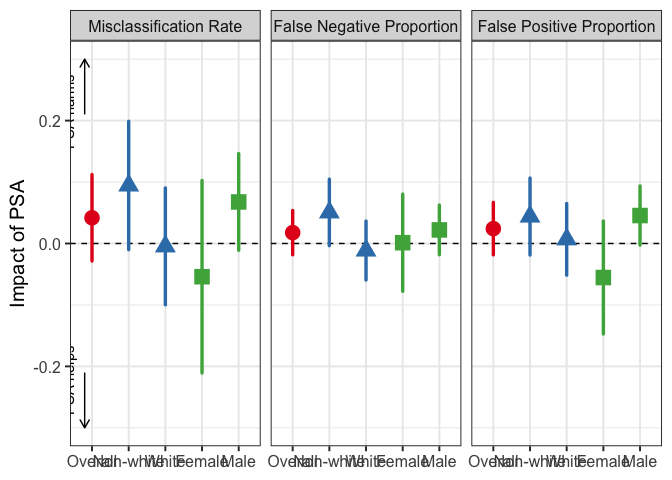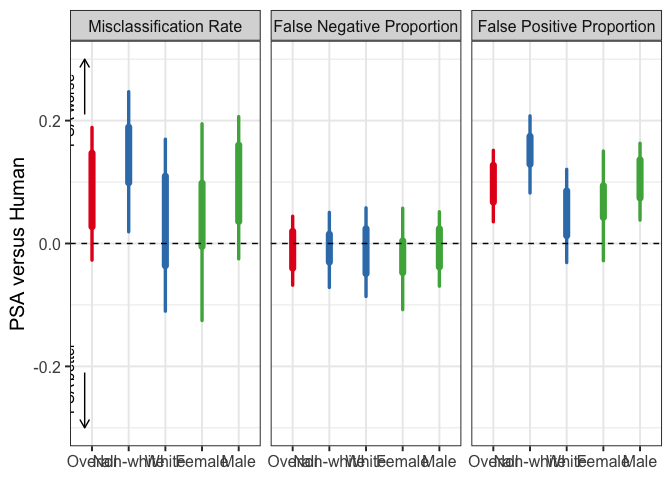The hardware and bandwidth for this mirror is donated by METANET, the Webhosting and Full Service-Cloud Provider.
If you wish to report a bug, or if you are interested in having us mirror your free-software or open-source project, please feel free to contact us at mirror[@]metanet.ch.
aihuman provides statistical methods for analyzing
experimental evaluation of the causal impacts of algorithmic
recommendations on human decisions developed by Imai, Jiang, Greiner,
Halen, and Shin (2023).
The data used for this paper, and made available here, are interim, based on only half of the observations in the study and (for those observations) only half of the study follow-up period. We use them only to illustrate methods, not to draw substantive conclusions.
You can install the development version of aihuman from
GitHub with:
# install.packages("devtools")
devtools::install_github("sooahnshin/aihuman", dependencies = TRUE, build_vignettes = TRUE)If you have trouble with compilation on macOS, you may want to check this link.
The package provides main functions for the methods proposed by Imai, Jiang, Greiner, Halen, and Shin (2023) based on principal stratification.
| Category | Function | Type | Main Input | Output | Paper | Notes |
|---|---|---|---|---|---|---|
| descriptive | PlotStackedBar() |
vis. | e.g., data(psa_synth) |
ggplot | Fig 1 | dist. of \(D_i\) |
| descriptive | CalDIMsubgroup() |
est. | e.g., data(synth) |
dataframe | Sec 2.4 | diff-in-means |
| descriptive | PlotDIMdecisions() |
vis. | output of
CalDIMsubgroup() |
ggplot | Fig 2 (left) | |
| descriptive | PlotDIMoutcomes() |
vis. | output of CalDIMsubgroup()
for each outcome |
ggplot | Fig 2 (right) | |
| main | AiEvalmcmc() |
est.(c/h) | e.g., data(synth) |
mcmc | Sec S5 | |
| main | CalAPCE() |
est.(c/h) | output of PSAmcmc() |
list | Sec 3.4 | |
| main | APCEsummary() |
est. | output of CalAPCE() |
dataframe | Sec 3.4 | APCE |
| main | PlotAPCE() |
vis. | output of APCEsummary() |
ggplot | Fig 4 | |
| strata | CalPS() |
est. | $P.R.mcmc of
CalAPCE() |
dataframe | Eq 6 | \(e_r\) |
| strata | PlotPS() |
vis. | output of CalPS() |
ggplot | Fig 3 | |
| fairness | CalFairness() |
est. | output of CalAPCE() |
dataframe | Sec 3.6 | \(\Delta_r(z)\) |
| fairness | PlotFairness() |
est. | output of CalFairness() |
ggplot | Fig 5 | |
| optimal | CalOptimalDecision() |
est. | output of AiEvalmcmc() |
dataframe | Sec 3.7 | \(\delta^\ast(\mathbf{x})\) |
| optimal | PlotOptimalDecision() |
vis. | output of
CalOptimalDecision() |
ggplot | Fig 6 | |
| comparison | PlotUtilityDiff() |
vis. | output of
CalOptimalDecision() |
ggplot | Fig 7 | \(g_d(\mathbf{x})\) |
| comparison | PlotUtilityDiffCI() |
vis. | output of
CalOptimalDecision() |
ggplot | Fig S17 | |
| crt | SpilloverCRT() |
est. | court event hearing date, \(D_i\), \(Z_i\) | daraframe | Sec S3.1 | |
| crt | PlotSpilloverCRT() |
vis. | output of SpilloverCRT() |
ggplot | Fig S8 | |
| crt power | SpilloverCRTpower() |
est. | court event hearing date, \(D_i\), \(Z_i\) | dataframe | Sec S3.2 | |
| crt power | PlotSpilloverCRTpower() |
vis. | output of
SpilloverCRTpower() |
ggplot | Fig S9 | |
| frequentist | CalAPCEipw() |
est. | e.g., data(synth) |
dataframe | Sec S7 | |
| frequentist | BootstrapAPCEipw() |
est. | e.g., data(synth) |
dataframe | ||
| frequentist | APCEsummaryipw() |
est. | outputs of CalAPCEipw() and
BootstrapAPCEipw() |
dataframe | ||
| frequentist (RE) | CalAPCEipwRE() |
est. | e.g., data(synth) |
dataframe | ||
| frequentist (RE) | BootstrapAPCEipwRE() |
est. | e.g., data(synth) |
dataframe |
vis. = visualization; est. = estimation; c/h = computation-heavy. You
may use CalAPCEparallel() instead of CalAPCE()
throughout the analysis.
For more details, see the aihuman package vignette,
vignette("aihuman", package = "aihuman").
library(aihuman)
## Using synthetic data with small run
data(synth)
sample_mcmc <- AiEvalmcmc(data = synth, n.mcmc = 10)
#> 10/10 done.
subgroup_synth <- list(1:nrow(synth),
which(synth$Sex == 0),
which(synth$Sex == 1),
which(synth$Sex == 1 & synth$White == 0),
which(synth$Sex == 1 & synth$White == 1))
sample_apce <- CalAPCE(data = synth,
mcmc.re = sample_mcmc,
subgroup = subgroup_synth)
# You can also use the parallelized version: check CalAPCEparallel()
sample_apce_summary <- APCEsummary(sample_apce[["APCE.mcmc"]])
PlotAPCE(sample_apce_summary,
y.max = 0.25,
decision.labels = c("signature", "small cash", "medium cash", "large cash"),
shape.values = c(16, 17, 15, 18),
col.values = c("blue", "black", "red", "brown", "purple"),
label = FALSE)
The package provides main functions for the methods proposed by Ben-Michael, Greiner, Huang, Imai, Jiang, and Shin (2024) based on a minimal set of assumptions.
| Category | Function | Type | Output | Figure # |
|---|---|---|---|---|
| Human+AI v. Human | compute_stats_aipw() |
est. | dataframe | |
| Human+AI v. Human | plot_diff_human_aipw() |
vis. | ggplot | Fig 1 |
| AI v. Human | compute_bounds_aipw() |
est. | dataframe | |
| AI v. Human | plot_diff_ai_aipw() |
vis. | ggplot | Fig 2, 5, S4 |
| Preference | plot_preference() |
vis. | ggplot | Fig 3, S5 |
| Agreement | table_agreement() |
est | ggplot | |
| Agreement | plot_agreement() |
vis. | ggplot | Fig S1 |
| Overrides | plot_diff_subgroup() |
vis. | ggplot | Fig S2, S3 |
| Policy learning | See the vignette | vis. | ggplot | Fig 4 |
For more details, see the ablity vignette,
vignette("ability", package = "aihuman").
library(ggplot2)
## set default ggplot theme
theme_set(theme_bw(base_size = 15) + theme(plot.title = element_text(hjust = 0.5)))
## Human+AI v. Human
plot_diff_human_aipw(
Y = NCAdata$Y,
D = ifelse(NCAdata$D == 0, 0, 1),
Z = NCAdata$Z,
nuis_funcs = nuis_func,
true.pscore = rep(0.5, nrow(NCAdata)),
l01 = 1,
subgroup1 = ifelse(NCAdata$White == 1, "White", "Non-white"),
subgroup2 = ifelse(NCAdata$Sex == 1, "Male", "Female"),
label.subgroup1 = "Race",
label.subgroup2 = "Gender",
x.order = c("Overall", "Non-white", "White", "Female", "Male"),
p.title = NULL, p.lb = -0.3, p.ub = 0.3
)
## AI v. Human
plot_diff_ai_aipw(
Y = NCAdata$Y,
D = ifelse(NCAdata$D == 0, 0, 1),
Z = NCAdata$Z,
A = PSAdata$DMF,
z_compare = 0,
nuis_funcs = nuis_func,
nuis_funcs_ai = nuis_func_ai,
true.pscore = rep(0.5, nrow(NCAdata)),
l01 = 1,
subgroup1 = ifelse(NCAdata$White == 1, "White", "Non-white"),
subgroup2 = ifelse(NCAdata$Sex == 1, "Male", "Female"),
label.subgroup1 = "Race",
label.subgroup2 = "Gender",
x.order = c("Overall", "Non-white", "White", "Female", "Male"),
zero.line = TRUE, arrows = TRUE, y.min = -Inf,
p.title = NULL, p.lb = -0.3, p.ub = 0.3
)
These binaries (installable software) and packages are in development.
They may not be fully stable and should be used with caution. We make no claims about them.